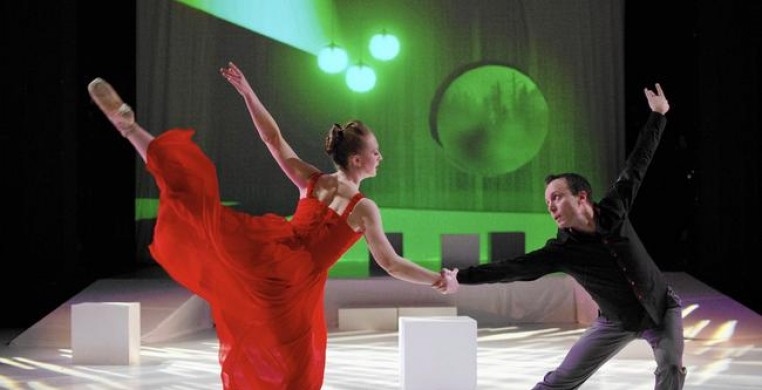Whether we blame the series of murders in William Shakespeare’s “MacBeth” on three mysterious witches casting spells on the royals or the impurities of mere mortals is the stuff of British literarians and theater scholars. I’ll leave any discussion of MacBeth and its many complexities to those actually qualified to comment, but what I can say is that it makes pretty great material for a ballet. Chicago Repertory Ballet (CRB) and Artistic Director/choreographer Wade Schaaf must have thought so too, as he takes on the tale of political ambition and the lengths to which individuals will go in order to gain power and prestige for the topic of Schaaf's first full-length ballet. Political ambition and extreme lengths… How timely.
Schaaf’s version, however, is not specific to any particular era. Rather, this MacBeth only hints at the Elizabethan period while playing in a space more symbolic or World War II, or maybe an undefined time in the near future. The design team, with John Pobojewski/Thirst Design’s projections, lighting by Sarah Lackner, costumes by Nathan Roher and a host of high caliber carpenters and video specialists, spared no expense for this “little company that could,” literally transforming the Ruth Page Center for the Arts into an immersive environment specifically customized for Schaaf’s ballet.
Pobojewski’s projections cast on the back wall of Page’s “upper stage” and onto the pony walls above the stage brilliantly capitalized on elements of this space typically thought of as weaknesses. Images of modern newscasts, marching armies, and haunting faces against Nathan Roher’s decidedly un-Shakespearean garb further contributed to the refreshing ambiguity toward any particular time period. Schaaf’s choreography matches the harmonious mix of antiquity and futurism, with some dancers in pointe shoes and others in socks or bare feet. Contemporary gesticulations are paired with a conventional polonaise, because, why not?!? The off-kilter atmosphere reminded me of the world behind the chalk drawn door in Beetlejuice. It’s an ideal setting for a story that crosses fanaticism with cold-blooded murder, and perhaps alludes to the timeless nature of Shakespeare, and history’s affinity for repetition.
In its fourth season, CRB has, until now, only presented mixed rep, mostly from a contemporary dance aesthetic. MacBeth is definitively ballet, although Schaaf’s movement vocabulary plays with conventional technique in new and interesting ways. The witches, here called The Weird Sisters, highlight Jacqueline Stewart in a strong and surprisingly balletic role, and the best ensemble dancing comes in the ballet’s third act, particularly as whirling forest nymphs dance around MacBeth with tree-like staffs. It is in the third act that Sarah Olson and Daniel Chenoweth as Lord and Lady McDuff take on a stunning duet, while featured dancers Tony Suhadolnik (MacBeth), and Jordan Mercer (Lady MacBeth) bear the brunt of the work in the first two. At times uneven, the dancing couldn’t always keep up with Schaaf’s spectacular vision or the sophistication of the design elements, but it might be important to remember that CRB is a part-time ballet company made up of freelance contemporary dancers. If Schaaf had the right number of dancers and a full-time rehearsal schedule, he very well might put up stiff competition for the biggest gigs in town. For now, one can’t help but admire his pluck and ambitious vision, and award bragging rights for bringing something different to the table. In the ballet’s final moments, music, dance, design, concept, and space unite harmoniously, and the room’s energy is apparent: we are rooting for this company. Bouncing onstage for the final curtain call, beaming with pride, Wade Schaaf’s mind is clearly celebrating the past and present, but more importantly looking toward the future.
Chicago Repertory Ballet’s MacBeth continues Mar. 11 and 12 at the Ruth Page Center for the Arts, 1016 N. Dearborn Pkwy.

